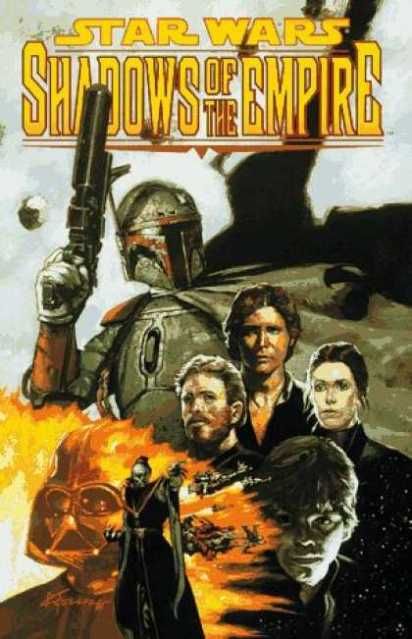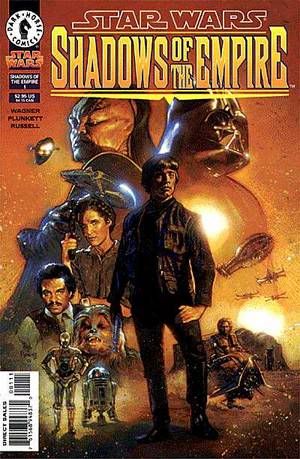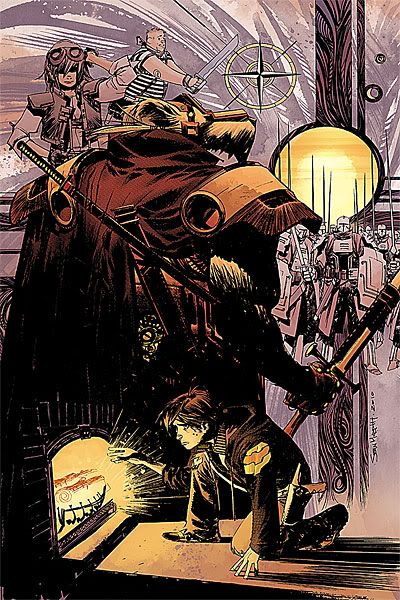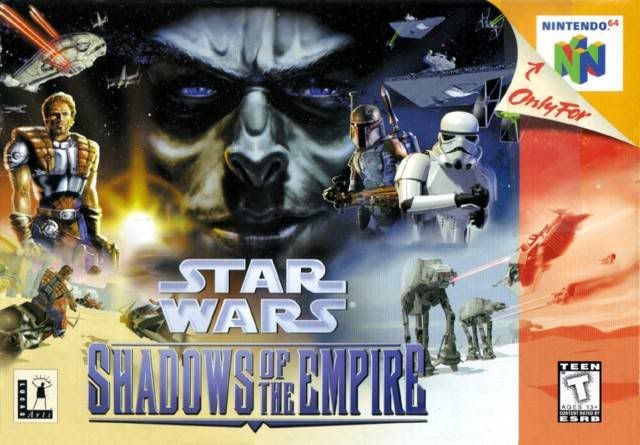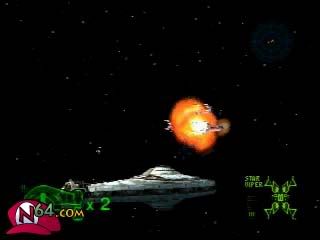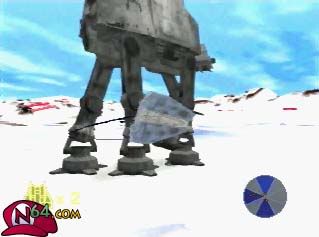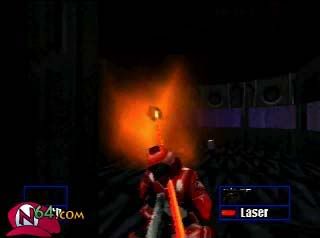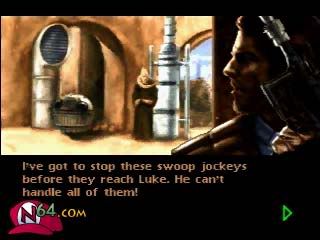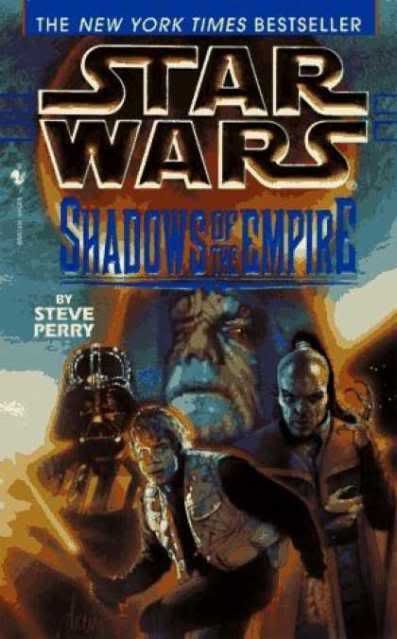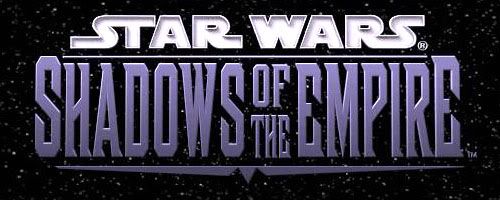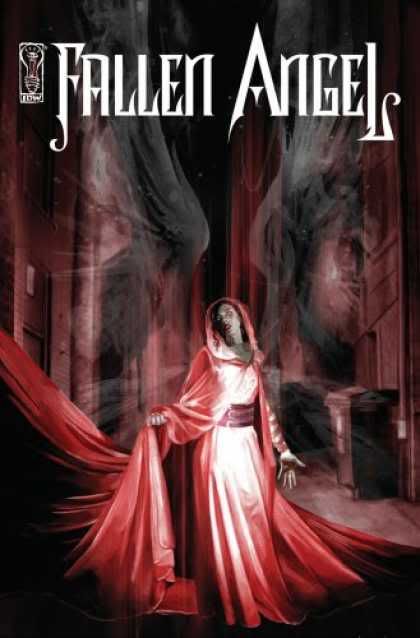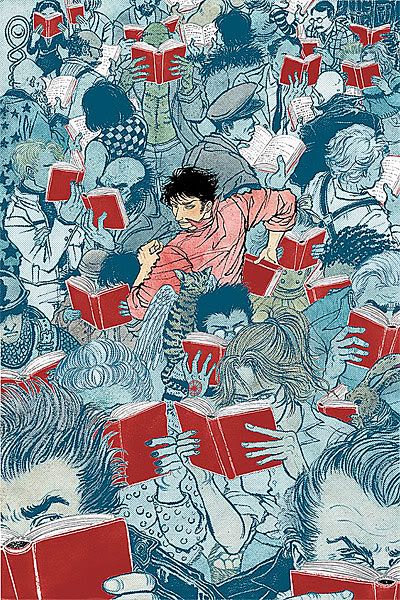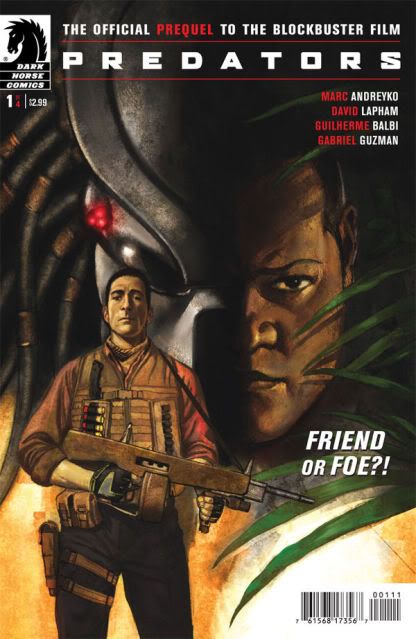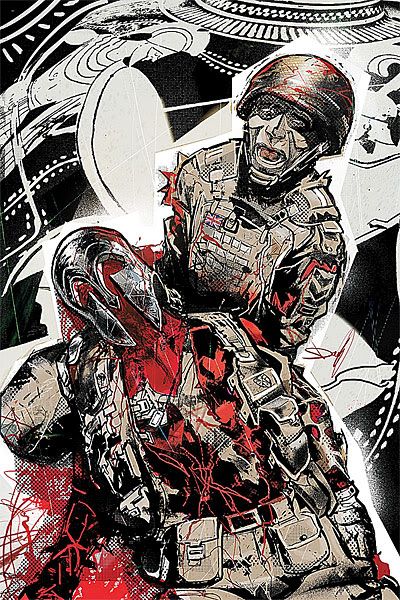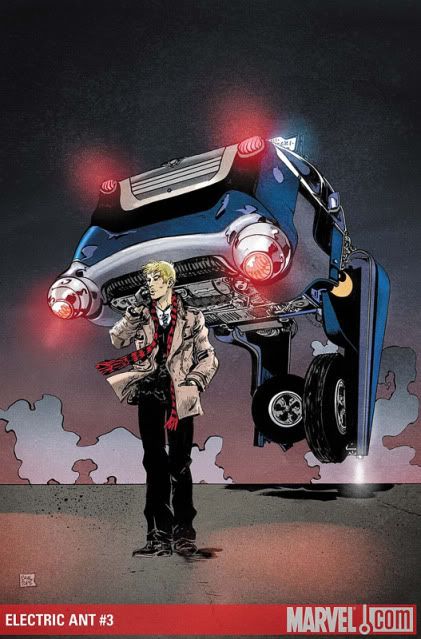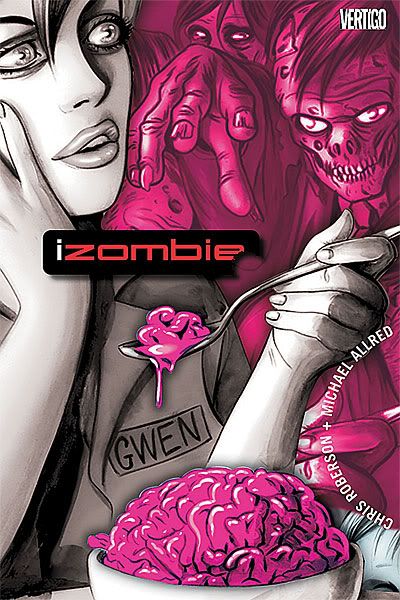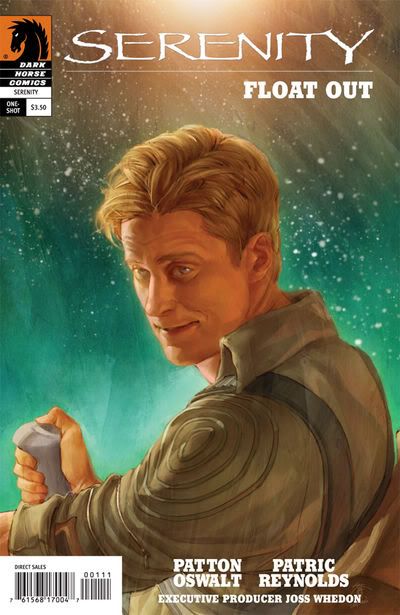Star Wars: Shadows of the Empire TPB
Writer--John Wagner
Artist--Kilian Plunkett
At last, we review the graphic novel compiling the six issue mini series of Shadows of the Empire. As I've stated before, this is where I came into comics and the Shadows of the Empire storyline. It all started with the lovely looking first issue at that crappy gas station in my hometown, and I still have that issue in my longbox today.
I truly wish that this is the way modern Star Wars books were done. It actually looks in line with the poster art of Drew Struzan rather than just another comic book. It sold me in 1996 and it sells me today in 2010.
But surely there must be more to it than the cover art, right?
To me, absolutely. However, I'm going to review this from the perspective of having read the novel, and how the book plays into the overall story.
As with the novel, Empire has just ended, Luke and Vader are recovering from their battle in Cloud City. The book opens with the traditional text scroll, in bold yellow across a star scape. Then, the rebel fleet is underneath. It's almost like the credits never started after the movie ended. The book dives right into a beautifully rendered space battle, depicting the heavily detailed star fighters of both the Alliance and the Empire. Already, it feels like we're home.
But following this sequence, the comic diverts it's attention from the heroes of the films. Instead, the graphic novel focuses on the villains, both in the Empire and in the underworld, vying for power in some way. The main characters of this book are Jix, an agent of Darth Vader, Xizor, and Boba Fett. Jix isn't very interesting as a character, but his interactions with Darth Vader are. I've already said that Vader comes into a light in Shadows, playing the role of the victim of the Emperor, and setting up for that slave-of-darkness tone present in Return of the Jedi. Jix is the person who draws this out of him to an extent, though not with his actions, but with the commands given to Jix. It's clear that Vader wants his son to live long enough to be with him, though in the service of evil. The more we get of Vader like this, the better. It's a side more common to his character in comics since, especially in The Force Unleashed by Hayden Blackman. Boba Fett is given a lot of focus in this comic, detailing his difficulties delivering Han Solo to Jabba the Hutt. These parts often give some humor to the book, as Fett speaks to the carbonite encased smuggler, complaining about how much of a nuisance he is. Whether it's intentional or not, you can't help but chuckle at the fan favorite talking to what is essentially an inanimate object. When he's not making himself out to be crazy, he participates in some exciting battles with other bounty hunters, reminding everyone how crafty and generally awesome he is. Sadly, I don't feel like he's given enough as a character, but that's just an aside. This is Star Wars after all, and we can't get such depth with every character.
The writing is on the higher end of the nineties Star Wars comic grade of quality. The characters don't step outside of their personalities, and the scenarios are well constructed and interesting. He keeps Dash Rendar from taking center screen too much, and even provides some exciting, tense sequences of action from time to time. However, his best work comes from the behind the scenes deconstruction of the Empire through Prince Xizor. His actions prove important to what happens in the series following the books end, and that's an admirable quality for the book to have given it's important placement in the time line.
Killian Plunkett's art is pretty good, though not amazing by any stretch. While ships, vehicles, and environments are drawn beautifully and technically, characters often have minor imperfections that could have been cleared up with a slightly higher attention to those details. The covers for all six issues are beautiful, and are included in the last pages of the trade. Overall, I must recommend this book, even if you don't intend to read the novel. It works as a stand alone story well enough. It has recently been reprinted as part of the Shadows of the Empire Omnibus by Dark Horse. Also included in the Omnibus are the sequel to Shadows, Evolution, and a Mara Jade mini-series that I may review at a later time on this site.
On the whole, the Shadows of the Empire multi-media event levels out as being a highly entertaining, though slightly flawed experiment in how LucasArts would market it's later projects and sell their stories. However, unlike more recent Star Wars works, this feels like Star Wars. The conflicts, characters, and even the music feel like I've been taken back to that galaxy, far away. If you have the time for the whole experience, I fully recommend it. However, the lone comic is the easiest and the only of the books that can be taken in as a singular work, not dependent on the events of the game or the novel to tell the complete story it's trying to tell. It's a fun trip, and you will learn some new things about how the galaxy really works.
5/5
Friday, June 25, 2010
Comic Reviews June 23rd 2010
Well, better late than never. I've been away from the computer quite a bit this week, so I'm behind. But, here are reviews of the books I picked up this week.
Predators #3--Dark Horse
Writers--Marc Andreyko, David Lapham
Artists--Guilherme Balbi, Gabriel Guzman
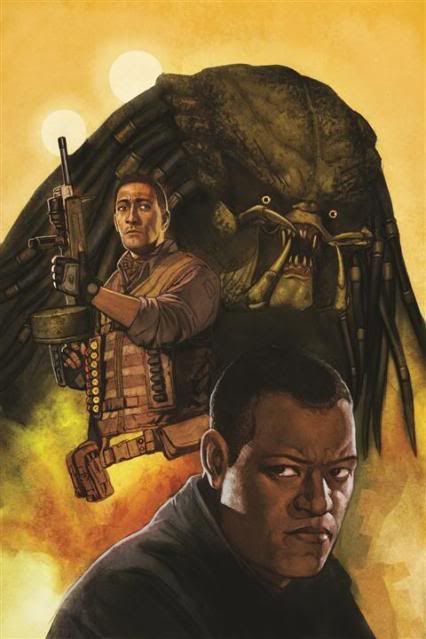
So, let's just get this out of the way. Predators continues to be just okay in it's third issue, trying to push for the upcoming conclusion. Welcome to the Jungle makes strives to make the characters likable for once, but it comes across flat. I wonder what makes Andreyko give such stereotypical dialogue to his characters. Instead of engaging what is actually an interesting scenario for this series (a four year survivor of the predators and the headstrong newcomer who will probably get them killed), and deliver it so lifelessly. Perhaps the fourth issue leads into the film with an ending ready to get us ready for the upcoming film. However, I'm leaning towards doubt, as that would imply that this book has some intelligence. David Lapham's A Predatory Life seems too short for the story it's trying to tell. I appreciate his efforts though, as he is doing more in his six pages than Andreyko is in his fourteen. Royce is an intriguing character, but there isn't enough of him on the page. All of his characterization has been done in subtitles, as he tactically performs his violent acts. Perhaps the prequel series would have been served well if the films main character had gotten a book of his own in lieu of a twenty four page snapshot of the character? Anyway, I will not be sad to see this book go following it's conclusion.
2.5/5
Air #22--DC/Vertigo
Writer--G. Willow Wilson
Artist--M.K. Perker
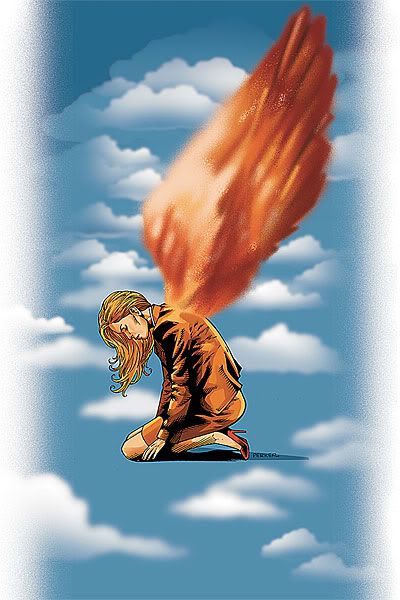
Like Greek Street, Air is a book that has had it's ups and downs with me. It started strong, with a satirical edge and smart dialogue, and descended into a story about romance and drug addiction during it's teens. Now it's reached issue twenty-two, and the series will be ending after two more issues. Luckily, Wilson has written a great issue playing off of many of the good aspects of the past eleven issues. Sure, the delicious post-9/11 satire of the first story arc is completely lost now, but Air still has a story to finish. Blythe is running into an antagonistic streak, fighting back against a lot of things in this issue, showing some backbone for the first time in the series. Honestly, it's about time she had some real strength, rather than falling on every one of the support characters or her aforementioned drug addiction. Also, the Amelia Earhart section was one of the most poignant moments of the series to this point. Perker's art is light on style, but perfect for Wilson's writing, focusing entirely on the characters rather than backgrounds or unnecessary details. Despite this, there was one or two moments where a couple of side characters looked a little off. This doesn't take away from the fact that this was a stellar entry in a series that isn't long from an ending. Consider this a recommendation for the entire series, with a warning of the middle. It's not as good as the series is capable of.
4.5/5
The Amory Wars: In Keeping Secrets of Silent Earth: 3
Writer: Claudio Sanchez with Peter David
Artist: Chris Burnham

"Ambitious" is probably one of the most overused words when it comes to art of any kind. Surely, I've used to too often. However, there aren't many other words I can think of when it comes to Claudio Sanchez's Coheed and Cambria story. Using the mediums of comics and music, he's planning to tell the story of the Keywork, Heaven's Fence, and the characters Coheed and Cambria. This is the second series associated with The Amory Wars. The first, The Second Stage Turbine Blade, was published by Image, and will soon be reprinted in hardback by Boom. They are handling the publishing duties for this series, based on Coheed and Cambria's (the band) second studio album of the same title.
When I read the first issue, I had great hopes for this series. I'd read the first volume of The Second Stage Turbine Blade, and found it a bit clunky, but ultimately entertaining. While I missed the second volume, I can honestly say that Claudio Sanchez has grown immensely as a story teller. The writing has been strong throughout, and the characters interesting. The scenario rings with just enough personal desperation for the main character, Claudio. If this is getting confusing, I'm sorry. The entire work is slightly autobiographical, so I hope you don't mind the nature of this review. Using the framework of an ongoing conversation with his dog, Apollo, Claudio (character) reveals the story of Wilhelm Ryan and Inferno with an honest voice and clear form. The only downside to the book is the art. It shifts from having wonderful environments and a great attention to detail, to being absolutely hideous. Wider shots are handled well enough, but close ups of any character tend to be so jarring to the eye that I questioned how the work passed muster with the editors. I'm not sure if this is just an issue of personal aesthetic, but I'm just going to leave it at that I don't like it. The lush visuals of the Good Apollo, I'm Burning Star IV graphic novel released parallel to the album of the same name were far more appealing, and further set my disappointment with this book's art. However, the story is worth grimacing at the art for, and I fully approve of where Claudio (the writer) is going. If you are a fan of the band, check it out, and the same goes for if you just like sci-fi comics.
4.75/5 (I really wanted to rate it full score...)
Predators #3--Dark Horse
Writers--Marc Andreyko, David Lapham
Artists--Guilherme Balbi, Gabriel Guzman

So, let's just get this out of the way. Predators continues to be just okay in it's third issue, trying to push for the upcoming conclusion. Welcome to the Jungle makes strives to make the characters likable for once, but it comes across flat. I wonder what makes Andreyko give such stereotypical dialogue to his characters. Instead of engaging what is actually an interesting scenario for this series (a four year survivor of the predators and the headstrong newcomer who will probably get them killed), and deliver it so lifelessly. Perhaps the fourth issue leads into the film with an ending ready to get us ready for the upcoming film. However, I'm leaning towards doubt, as that would imply that this book has some intelligence. David Lapham's A Predatory Life seems too short for the story it's trying to tell. I appreciate his efforts though, as he is doing more in his six pages than Andreyko is in his fourteen. Royce is an intriguing character, but there isn't enough of him on the page. All of his characterization has been done in subtitles, as he tactically performs his violent acts. Perhaps the prequel series would have been served well if the films main character had gotten a book of his own in lieu of a twenty four page snapshot of the character? Anyway, I will not be sad to see this book go following it's conclusion.
2.5/5
Air #22--DC/Vertigo
Writer--G. Willow Wilson
Artist--M.K. Perker

Like Greek Street, Air is a book that has had it's ups and downs with me. It started strong, with a satirical edge and smart dialogue, and descended into a story about romance and drug addiction during it's teens. Now it's reached issue twenty-two, and the series will be ending after two more issues. Luckily, Wilson has written a great issue playing off of many of the good aspects of the past eleven issues. Sure, the delicious post-9/11 satire of the first story arc is completely lost now, but Air still has a story to finish. Blythe is running into an antagonistic streak, fighting back against a lot of things in this issue, showing some backbone for the first time in the series. Honestly, it's about time she had some real strength, rather than falling on every one of the support characters or her aforementioned drug addiction. Also, the Amelia Earhart section was one of the most poignant moments of the series to this point. Perker's art is light on style, but perfect for Wilson's writing, focusing entirely on the characters rather than backgrounds or unnecessary details. Despite this, there was one or two moments where a couple of side characters looked a little off. This doesn't take away from the fact that this was a stellar entry in a series that isn't long from an ending. Consider this a recommendation for the entire series, with a warning of the middle. It's not as good as the series is capable of.
4.5/5
The Amory Wars: In Keeping Secrets of Silent Earth: 3
Writer: Claudio Sanchez with Peter David
Artist: Chris Burnham

"Ambitious" is probably one of the most overused words when it comes to art of any kind. Surely, I've used to too often. However, there aren't many other words I can think of when it comes to Claudio Sanchez's Coheed and Cambria story. Using the mediums of comics and music, he's planning to tell the story of the Keywork, Heaven's Fence, and the characters Coheed and Cambria. This is the second series associated with The Amory Wars. The first, The Second Stage Turbine Blade, was published by Image, and will soon be reprinted in hardback by Boom. They are handling the publishing duties for this series, based on Coheed and Cambria's (the band) second studio album of the same title.
When I read the first issue, I had great hopes for this series. I'd read the first volume of The Second Stage Turbine Blade, and found it a bit clunky, but ultimately entertaining. While I missed the second volume, I can honestly say that Claudio Sanchez has grown immensely as a story teller. The writing has been strong throughout, and the characters interesting. The scenario rings with just enough personal desperation for the main character, Claudio. If this is getting confusing, I'm sorry. The entire work is slightly autobiographical, so I hope you don't mind the nature of this review. Using the framework of an ongoing conversation with his dog, Apollo, Claudio (character) reveals the story of Wilhelm Ryan and Inferno with an honest voice and clear form. The only downside to the book is the art. It shifts from having wonderful environments and a great attention to detail, to being absolutely hideous. Wider shots are handled well enough, but close ups of any character tend to be so jarring to the eye that I questioned how the work passed muster with the editors. I'm not sure if this is just an issue of personal aesthetic, but I'm just going to leave it at that I don't like it. The lush visuals of the Good Apollo, I'm Burning Star IV graphic novel released parallel to the album of the same name were far more appealing, and further set my disappointment with this book's art. However, the story is worth grimacing at the art for, and I fully approve of where Claudio (the writer) is going. If you are a fan of the band, check it out, and the same goes for if you just like sci-fi comics.
4.75/5 (I really wanted to rate it full score...)
Joe the Barbarian #6--DC/Vertigo
Writer--Grant Morrison
Artist--Sean Murphy
This is the latest in the series that has sold me on Grant Morrison. However, this isn't the strongest book in the run. This issue definitely feels like a transitional chapter, moving the characters into position for the final two issues that will wrap up the series. Don't let this fool you. It's still the best mini-series going right now. Joe's journey to find a soda and end his hallucinogenic nightmare is still as engaging and creative as it was in issue one. Since the book seems to be in setup mode, the art gets all of the chance to shine here. The series has played around the idea of imagination a lot, using Joe's toys and how he uses his own home to play with those toys as the central point for how the visuals work, and how he trips around his house trying to reach the basement. So, there are many splash pages dedicated to setting vast scenes in the beautiful Hearth Castle (Joe's real world fireplace), and the juxtaposition of these fantastic realms and his own simple home still make an incredible impact. If you aren't reading this series, I can't stress enough how empty your collection is without it. If not now, pick it up when it goes to trade. It's worth every second of your attention, and is probably the best mini-series running this year.
4/5
Next week I'm going to finish reviewing the Predators mini-series, and I've got three Star Wars books coming out. I know, I know, you probably wish I would shut up about Star Wars after this week. Anyway, the penultimate issue of SW:Legacy is coming out, as well as the last issue of SW:Dark Times' Blue Harvest arc. Rounding them out is second issue in the Rescues arc of SW:Invasion. It's going to be a good week for me if nothing else.
3rdstar
Next week I'm going to finish reviewing the Predators mini-series, and I've got three Star Wars books coming out. I know, I know, you probably wish I would shut up about Star Wars after this week. Anyway, the penultimate issue of SW:Legacy is coming out, as well as the last issue of SW:Dark Times' Blue Harvest arc. Rounding them out is second issue in the Rescues arc of SW:Invasion. It's going to be a good week for me if nothing else.
3rdstar
Shadows of the Empire-- Soundtrack Review

So, how does LucasArts fill the absence of John Williams? Why, calling on someone who followed him up once before! Joel McNeely wrote music for the Young Indiana Jones series a few years previous, as per suggestion of Williams himself. However, this project is still a bit daunting. He's scoring a film that doesn't exist, using the novel, and some artwork by Ralph McQuarrie as the only sources.
According the liner notes included with the CD, McNeely thought of having these inspirations only as freeing rather than constricting, allowing him more musical room with each scene he scored than a film would normally allow. This concept proves to serve him well through the ten tracks he's given us.
McNeely doesn't try to divert attention from the fact that John Williams is the true composer for the Star Wars universe. Two tracks on the record feature compositions famous to the original trilogy, and blend them amongst new melodies and themes of his own. The first, and most obvious, is the Star Wars theme, setting the tone for the record to come. The theme from The Imperial March plays during Night Skies, as does the main theme from Binary Sunset (uncredited on the album, which is evocative of Williams score for The Empire Strikes Back throughout it's entirety.
Also, Williams use of leitmotif isn't ignored in McNeely's score. Prince Xizor is given his own theme, a slinky, well paced piece of music that isn't as foreboding as I'd have liked for it to have been. The book depicts Xizor as a manipulative criminal, and while moments of the piece could have done well to musically depict this aspect of the story's villan, it ultimately disappoints by being disjointed, and ultimately disappointing. If you are listening to the album, about a minute into the piece, there is a haunting string section, with choral chants filling out the overall atmosphere. The remainder of the piece reminds me more of Williams work on Attack of the Clones. Subtly, McNeely references melodies from this theme in the final work on the record, The Destruction of Xizor's Palace. Because of the stability of the piece, it plays out far better than Xizor's Theme, providing the necessary bombast for a climactic space/on foot battle. The shifts in theme and melody are strong, sweeping; vast enough to provide the necessary "Star Wars Feel" that I've been rambling about this week when discussing this project.
Where McNeely ultimately succeeds on this score are the moments where he brings something of himself to the musical table. Sure, the references to John Williams and the prerequisite melodic feel provided in those tracks are sure to set anyone's nostalgia reeling. But McNeely has no problem dipping his hands into different tonalities than Williams. Sure, Beggars Canyon Chase is an original piece of music that feels like John Williams, but the folk textures of The Southern Underground and stark dissonant chords of Battle of Gall and The Destruction of Xizor's Palace don't ring well with Williams' own traditional sensibilities. Nor does the waltz-like pacing of The Seduction of Princess Leia. While I wouldn't give up McNeely's loving homages to the classic trilogy scores, I'd love to hear more of his own contributions in here.
In rating this album, I have to ask the question of whether or not this album fits the story told. This is what is necessary of any soundtrack, so why should the score to a novel be any different. So, my answer is yes with a giant "but" at the end. This album is a high quality addition to any soundtrack library, and does well for being a Star Wars soundtrack as well. However, it definitely could have been better with more fluid compositions and if the melodies were more in line with the characters, in such places as Xizor is concerned. There were too many moments where the piece would just stop, and then pick up with the next theme. This is sloppy composition, where even the vinyl copy of the soundtrack to Star Wars (Episode IV: A New Hope for all of the obsessives...like me) carried a strong flow from one track to the next, despite missing massive sections of music from the overall film. Perhaps I'm spoiled by the remastered CD scores of the original trilogy, where listening to the album feels like I'm watching the film without the need for the visual aspect. But that doesn't do this record justice. It's worth a listen, and possibly worth a purchase for those of us who love the music of Star Wars.
And let's be honest, there's no way you would even look at this CD if you weren't a fan of Star Wars in the first place.
4/5
Tuesday, June 22, 2010
Shadows of the Empire--Game Review
Alright, it's time for round two of my massive Shadows of the Empire review. Today, I've set my sights on the Nintendo 64 launch title. But before I start commenting on the game itself, let's set up a little background on gaming at the time.
It was 1996, 3D graphics were still in it's early stages of development, and few games outside the PC had done it right. Another N64 launch title, Super Mario 64, displayed great promise in what could be done with 3D graphics on the console, so expectations were high right from the start. However, the N64 was notoriously difficult to develop for, due to Nintendo keeping the cartridge format alive for another generation, and the complexity of the hardware architecture. These problems plagued the N64 throughout it's entire lifespan, causing many A-list titles to be developed for the weaker, yet still capable Sony Playstation, giving it the edge on the console wars, and putting Nintendo behind for the first time since they made the NES back in the 1980's.
Shadows of the Empire was one of those launch games that didn't exactly have the best control of what it was trying to do. It was an ambitious title, attempting to blend platforming, third and first person shooter elements, and flight combat all into one game. It hadn't been done before, but it felt like an evolution from the Super Star Wars games for the Super Nintendo. Those games were focused on run-and-gun Contra-esque gameplay, and had amazing Mode-7 driven flight stages spread throughout. However, the 2D and false 3D gameplay worked better than on the N64, even though the games were still far more difficult than any of their action game contemporaries. Shadows suffered from poor controls, a murky 3D engine, and some moments of poor level design. But, in my opinion, the game is still a blast to play.
The flight levels steal the show right from the beginning. The game starts with a stellar Battle of Hoth level which developers would rip off any time a Galactic Civil War era game was developed. Shooting down probe droids and sinking AT-AT's proved to be a smooth and exciting moment for the game. This level was executed well it was the single inspiration for Factor 5's Rogue Squadron series three years later. Other flight levels include an attack on Prince Xizor's SkyHook and a slew of Virago fighters, and a trip through the Hoth asteroid field. The only example of a bad vehicular stage is the Swoop Bike chase through Mos Eisley and into Beggars Canyon. It's a bit of a mixed bag, as the level is difficult to navigate, and the swoop gang is a stunning example of poor AI.
With brilliantly executed flight levels, where did this game go wrong during the ground missions? This is where the poor 3D engine comes into play. Platforming in 3D was still new, as I said, and this is an example of a poor effort. The escape from Echo Base in level two doesn't fare as poorly as later missions such as Gall Spaceport, but it all feels repetitious and weak throughout. The mission on Gall is probably the worst sequence in the game; long drawn out sections of jet pack driven platforming over foggy canyons to small indistinguishable rocks while being shot at by stormtroopers you can't even see. Without doubt, you'd need the patience of several Jedi to not scream at your sixteenth death trying to navigate this mess of a level. Pass this, however, and you get the game's most rewarding boss fight: Boba Fett.
Sadly, other boss fights aren't as inspired as this. The AT-ST battles that occur frequently throughout the game equate to running in a circle and shooting. The battle with IG-88 doesn't even come across as particularly inspired. The only remaining battles are with droids or a giant dianoga, and the latter is more frustrating than it is fun.
Without any doubt, Dash Rendar, the game's main character, is a massive disappointment. He's a poor mans Han Solo, right down to his ship, the Outrider. I get that the Corellian shipyards would have constructed more than one model of YT-#### frigate, but I seriously doubt that all smugglers and mercenaries that the Rebel Alliance would talk to flies just that series of ship! If you can swallow this guy's participation in the game, then you are okay to sludge through the rest.
You must be asking now why I look at this game so kindly when asked about it. The answer is simple: it's a Star Wars game that actually feels like I'm in the Star Wars universe. Many games that have come out since the prequel films don't have the same feeling, and to me, that is vital to the experience. The musical score and epic feel of the game provide everything that is necessary to make this a Star Wars experience, even if the gameplay falls flat. I give the same explanation as to why I enjoyed Rebel Assault 2 as well, and that game is as cheesy and dated as games could possibly be at this point.
As for the games place in the Shadows of the Empire story, it basically fills in all of those spots that are missing from the book. Recovering the plans for the second Death Star from the Imperial Freighter Suprosa, Dash saving Luke from Jabba's swoop gang, and other gaps in the story are filled in sufficiently, even though they were done needlessly. The two books that tell the story around the game do so better than the in game text based cut scenes. For the N64 to use a method of storytelling such as this is also a bit disappointing, because we were all expecting video cutscenes such as the Playstation was giving at the time. For the weaker system to deliver the higher quality cutscenes, LucasArts wasn't doing the Nintendo any favors. Especially since they had the video cutscenes from the PC version, this is somewhat inexcusable.
Overall, I still enjoy the game, but I realize it's flaws. If you aren't so obsessed with modern graphics, and can get around the messiness of the experience, go out and pick this one up. It's cheap enough and there are several hundred thousand copies floating around in used bins at game shops everywhere. It's definitely an example of where video games were then, and how far they have come.
3.5/5
Tommorow, I'm going to review the soundtrack CD, as I don't have the cash to pick up my Wednesday books yet. Look for that review on Thursday, and the finale to the Shadows of the Empire review on Friday, where I will take a look at the comic book mini-series that fills in the rest of the gaps.
Screenshots courtesy of www.ign.com
Monday, June 21, 2010
Shadows of the Empire--Novel Review
I didn’t read the novel until 2009, so when I first cracked open my paperback copy of Shadows of the Empire, I was struck with a bit of whiplash. The timing seemed to be off quite a bit by the standards of the comic mini-series, which picked up immediately after The Empire Strikes Back. And since this was the book that focused on the characters familiar of Luke, Leia, and Lando, it was a better entry point for the story to people who hadn’t been into the expanded universe before this book.
So, what’s to explain about the setup of this book? Obviously, if you saw ESB, you already know that Han Solo was already captive of Boba Fett, and being taken to Jabba the Hutt, Luke was traumatized by finding out Darth Vader was his father, and Lando was guilty of being an idiot and getting his friends captured by the Empire. And that’s exactly where the book picks up. However, the story of our famed heroes hunting down Boba Fett isn’t what makes this book what it is. The villains take the lead here.
Darth Vader takes the lead in Shadows of the Empire, facing a threat he considers worse than the Rebel Alliance: Prince Xizor, a Falleen, and head of the Black Sun crime syndicate. Xizor was brought in by the Emperor to fast track the construction of the second Death Star. Not trusting Xizor, Darth Vader fights a war of words with him, as they slink their way around each others actions.
Vader’s insecurities with Xizor being so close to the Emperor adds an interesting depth to Vader as a character, and does wonders for the relationship between the two Sith lords. While Return of the Jedi and the prequel films depict their relationship as more slave/master, Shadows of the Empire almost makes it seem like father and son. Xizor is the new kid in town, and being sent on worthless missions makes Vader feel unwanted in the Emperors court. While it’s not quite as innocent as this, and there is a lot more violence involved, it’s interesting to note this shift in how we can see Vader.
Prince Xizor is one of the new characters created for the series, and as I mentioned, Vader’s true foe. He’s cold, tactical, and probably the most oversexed character in the Star Wars universe. Yes, folks, the lizard man, Xizor, attempts to seduce…
Well, I’ll let your read the books to find that out.
Anyway, Steve Perry brought the story to life for the most part, but I can’t say that the book is perfect. On one hand, there is his idea of humor. It works sometimes, but there is a moment in the story which is a bit on the side of infamous at this point. Towards the climax, C-3P0 and R2-D2 fly the Millennium Falcon. No, it doesn’t work that well. The other problem with the book is that it is subject to being part of the multimedia project of Shadows of the Empire. Since it was a novel, rather than the comic, it should have been able to work in all of the important details from the other stories rather than glossing over them.
However, these flaws don’t hinder the overall experience too much. Between a new look at classic characters in the moment that we know them best (Galactic Civil War era), and interesting new friends and foes, Shadows of the Empire is an excellent book to fill in the gap between Empire and Jedi. As for it being a decent place to start in the Expanded Universe, you can do better, but don’t let that stop you.
4.5/5
Tomorrow, we’re going to take a look at the LucasArts video game for the Nintendo 64. Hope you’ll check it out.
Shadows of the Empire-- A WEEK LONG REVIEW!
When I was in fifth grade, there wasn’t anything in this world better than Star Wars. I read novels, played the video games, watched the movies endlessly, had lightsaber fights with my friends, action figures, quite literally I was into everything Star Wars. Then, in a dingy little gas station less than a mile from my house, my best friend found a comic book. I didn’t care about comic books, but this was special.
It was a Star Wars comic. And it was the first issue of Shadows of the Empire.
A week later I convinced my grandmother to take me up there to get it. I pad in change, taking the precious little paper book home with me, and read it at least six times that week. This was the first, and still one of my favorite comics. I’m not sure if it’s just nostalgia coming into play, but I still consider Shadows of the Empire something special. It is follow up to my favorite of the Star Wars films, Empire Strikes Back, taking place almost immediately after the film cuts to credits. It’s part of the reason I love cover art and poster art.
So, I’m going to review it.
But not just the comic! Shadows of the Empire was a multi-media event when it was started in 1996. The concept behind it was to create everything for a movie, except for the movie. And that’s what they accomplished, with a novel, comic book series, soundtrack, video game, and a line of action figures. There is even a couple of source books dedicated to this one moment in time for the Star Wars D20 Modern RPG. But, I’m just going to review the concrete stuff. I’ll be starting off with a review of the novel by Steve Perry. On Tuesday, I’ll review the video game. Wednesday will be a standard review day for weekly books. Thursday, I’ll review the soundtrack, and finally on Friday, a review of the comic book series that brought me back to comics in 2008.
It was a Star Wars comic. And it was the first issue of Shadows of the Empire.
A week later I convinced my grandmother to take me up there to get it. I pad in change, taking the precious little paper book home with me, and read it at least six times that week. This was the first, and still one of my favorite comics. I’m not sure if it’s just nostalgia coming into play, but I still consider Shadows of the Empire something special. It is follow up to my favorite of the Star Wars films, Empire Strikes Back, taking place almost immediately after the film cuts to credits. It’s part of the reason I love cover art and poster art.
So, I’m going to review it.
But not just the comic! Shadows of the Empire was a multi-media event when it was started in 1996. The concept behind it was to create everything for a movie, except for the movie. And that’s what they accomplished, with a novel, comic book series, soundtrack, video game, and a line of action figures. There is even a couple of source books dedicated to this one moment in time for the Star Wars D20 Modern RPG. But, I’m just going to review the concrete stuff. I’ll be starting off with a review of the novel by Steve Perry. On Tuesday, I’ll review the video game. Wednesday will be a standard review day for weekly books. Thursday, I’ll review the soundtrack, and finally on Friday, a review of the comic book series that brought me back to comics in 2008.
Saturday, June 19, 2010
Weekly Graphic Novel Review: Fallen Angel Vol. 1--To Serve in Heaven
Fallen Angel Vol. 1--To Serve in Heaven
Writer--Peter David
Artist--J.K. Woodward
So, let's get the obvious out of the way: this book is beautiful. The above image isn't even one of the best examples, and it sold me on Woodward's visuals. The world of Bette Noir is brought to life with surreal hand painted panels, in a deep color palette that sets the tone before you've read the first bit of text. Even as the scene shifts between the present day, and the back story of Liandra, the titular fallen, you will continue to be amazed by what has been done on the page. Some of the books finest moments are foundation shots of the streets of Bette Noir. I know this is going to sound like a pun, and for that I apologize, but it screams of film noir. But of course, this all means very little if the story isn't engaging.
Well, you are lucky. Peter David has taken great care in his writing, and rebooted his DC comic of the same title for IDW, allowing new readers to not be completely lost in the dark, and serve the previous story's fans. While I can't comment on the continuity between these two series, I'm just going to say that I wasn't lost when I read it, so most readers will probably not have any trouble jumping right in. If nothing else, there is a decent chance they are going to hunt down the DC books (which are soon to be reprinted in omnibus form by IDW).
The story is about Liandra, or Lee. By day, she is a college physical education teacher, and by night, defends the city of Bette Noire from the evil of the Heirarchy as their will is done by the Magistrate, Doctor Juris. Quickly, this becomes more complicated, as Juris attempts to pass on his position to his son, Jubal. This sets an origin story for Lee, how she fell from being a guardian angel, refusing the concept of free will. The origin story is told through several flashbacks, and David really builds the flashbacks into play naturally, slowly revealing the complexities of Liandra's current character.
Lee is easily one of the most interesting 'superhero' type characters I've read. Her powers are vast, but understated in favor or telling a story. We see her shoot lasers from her eyes a couple of times, but it never takes the center screen in favor of building on her relationships with the different people in the city. The Magistrate, Juris, is a selfish man, seeking his true first born sun, who would take his charge away from him forever. Then there is Xia, who comes across quickly as an agitated person by character. Xia, Juris, and Jubal have an interesting chemistry to their arrangement. Juris doesn't want. However, to a point, I didn't find myself wanting them there either. But, David still had their spot in the story, and I agree with it to a point. If he was just trying to get us to be annoyed by Juris and his thoughts and actions, then he suceeded with flying colors. Still, Lee is the main character, and who we spend the most time with as readers. She had a deep and interesting back story.
As a person of religious faith, I feel I should comment on David's statements about faith, religion, and God Himself. No, I'm not offended. Lee is a rebellious person in the eyes of The Boss, but it's not written in such a way as to say "Go burn down a church, Johnny" like some other works of fiction that are critical of organized religion. Instead, it's an alternative view of the nature of our existence, and it's intriguing. It's a bit frightening even, as it almost seems like a valid viewpoint. In short, I appreciate David's handling of the content. It's got the markings of a target for controversy, but it's not a blatant cross inverting, pentagram drawing, number of the beast screaming work of fiction that so many other writers allow their religious criticisms to be.
The book I read for my review is a paperback print of the first story arc. As I mentioned before, it's a lovely cover, depiticting Liandra in a haunting view of Bette Noir. It does little to speak for what's inside, and doesn't really show the city itself for what it is. The inclusion of the different cover arts was nice, as many trades don't tend to do this like they should. Also, there is a step by step walkthrough of J.K. Woodward's process for drawing and painting the book. Not necessary to the story, but a worthwhile addition nonetheless.
Whether you should start with the DC books or not is completely up to you. I read this trade with little trouble, so it won't hinder your experience. I feel like this book is solid enough to warrant a recommendation. The story is interesting, and at times stellar. The art is definitely the books high point. Check it out.
4/5
Coming up next week, I've got the surprise review coming out, as well as reviews of Air, Joe the Barbarian, Amory Wars, and the next issue in Dark Horse's Predators mini-series.
Writer--Peter David
Artist--J.K. Woodward
So, let's get the obvious out of the way: this book is beautiful. The above image isn't even one of the best examples, and it sold me on Woodward's visuals. The world of Bette Noir is brought to life with surreal hand painted panels, in a deep color palette that sets the tone before you've read the first bit of text. Even as the scene shifts between the present day, and the back story of Liandra, the titular fallen, you will continue to be amazed by what has been done on the page. Some of the books finest moments are foundation shots of the streets of Bette Noir. I know this is going to sound like a pun, and for that I apologize, but it screams of film noir. But of course, this all means very little if the story isn't engaging.
Well, you are lucky. Peter David has taken great care in his writing, and rebooted his DC comic of the same title for IDW, allowing new readers to not be completely lost in the dark, and serve the previous story's fans. While I can't comment on the continuity between these two series, I'm just going to say that I wasn't lost when I read it, so most readers will probably not have any trouble jumping right in. If nothing else, there is a decent chance they are going to hunt down the DC books (which are soon to be reprinted in omnibus form by IDW).
The story is about Liandra, or Lee. By day, she is a college physical education teacher, and by night, defends the city of Bette Noire from the evil of the Heirarchy as their will is done by the Magistrate, Doctor Juris. Quickly, this becomes more complicated, as Juris attempts to pass on his position to his son, Jubal. This sets an origin story for Lee, how she fell from being a guardian angel, refusing the concept of free will. The origin story is told through several flashbacks, and David really builds the flashbacks into play naturally, slowly revealing the complexities of Liandra's current character.
Lee is easily one of the most interesting 'superhero' type characters I've read. Her powers are vast, but understated in favor or telling a story. We see her shoot lasers from her eyes a couple of times, but it never takes the center screen in favor of building on her relationships with the different people in the city. The Magistrate, Juris, is a selfish man, seeking his true first born sun, who would take his charge away from him forever. Then there is Xia, who comes across quickly as an agitated person by character. Xia, Juris, and Jubal have an interesting chemistry to their arrangement. Juris doesn't want. However, to a point, I didn't find myself wanting them there either. But, David still had their spot in the story, and I agree with it to a point. If he was just trying to get us to be annoyed by Juris and his thoughts and actions, then he suceeded with flying colors. Still, Lee is the main character, and who we spend the most time with as readers. She had a deep and interesting back story.
As a person of religious faith, I feel I should comment on David's statements about faith, religion, and God Himself. No, I'm not offended. Lee is a rebellious person in the eyes of The Boss, but it's not written in such a way as to say "Go burn down a church, Johnny" like some other works of fiction that are critical of organized religion. Instead, it's an alternative view of the nature of our existence, and it's intriguing. It's a bit frightening even, as it almost seems like a valid viewpoint. In short, I appreciate David's handling of the content. It's got the markings of a target for controversy, but it's not a blatant cross inverting, pentagram drawing, number of the beast screaming work of fiction that so many other writers allow their religious criticisms to be.
The book I read for my review is a paperback print of the first story arc. As I mentioned before, it's a lovely cover, depiticting Liandra in a haunting view of Bette Noir. It does little to speak for what's inside, and doesn't really show the city itself for what it is. The inclusion of the different cover arts was nice, as many trades don't tend to do this like they should. Also, there is a step by step walkthrough of J.K. Woodward's process for drawing and painting the book. Not necessary to the story, but a worthwhile addition nonetheless.
Whether you should start with the DC books or not is completely up to you. I read this trade with little trouble, so it won't hinder your experience. I feel like this book is solid enough to warrant a recommendation. The story is interesting, and at times stellar. The art is definitely the books high point. Check it out.
4/5
Coming up next week, I've got the surprise review coming out, as well as reviews of Air, Joe the Barbarian, Amory Wars, and the next issue in Dark Horse's Predators mini-series.
Wednesday, June 16, 2010
Comic Review June 15th 2010
Oh, what a sad week it is. Here I sit, between all of my favorite series' releases, and I have but one book to comment on, the second issue of the Predators, the prequel to the upcoming film.
Predators #2--Dark Horse
Writers--Marc Andreyko, David Lapham
Artists--Guilherme Balbi, Gabriel Guzman
Alright, so I said last week that I wasn't excited after the first issue. Flat, lifeless characters filled the first half, and talky narrations filled every page in both stories. I'm sad to say that nothing has changed, and I already feel that the series will have done all that it can for me by the close of the third issue, and I will be out twelve dollars total by the end of the fourth. Welcome to the Jungle still proves that Andreyko is pulling a paycheck rather than telling a story. Drake is as generic as military characters come, every line streaked with bravado and idiocy so thick that it's hard to take him seriously. The art even suffers this issue, with awkward character models in almost every panel. In A Predatory Life, Royce continues to ramble endlessly about his views on his foes in the jungle and how he maintains who he is in the world. Well, if I hadn't read this in the first issue, I'd continue to be interested. Maintaining character is a good thing, but just rehashing dialogue doesn't make those characters three dimensional. Instead, Royce comes across as a self important jerk more than anything else. Still, the story here is at least more interesting than the former, not relying on the titular monsters to drive the story told. At this point, I don't expect the series to improve. It's a cheap cash-in on a film that I don't expect to be of high quality either. Oh well, I'll continue to do my duty next week, reviewing issue three, and then the fourth in two weeks. At least I will have something to take the taste out of my mouth.
Coming up Friday: It's a toss-up between another Warren Ellis book, Ministry of Space, or the first trade of Fallen Angel from IDW, penned by Peter David. And if time permits, I've got a special surprise for Monday. Stay tuned, folks.
A note:
Looks like I won't be reviewing Ministry of Space. Look for the review of Fallen Angel Vol. 1 tomorrow. Also, I'm still working on the special review on Monday.
3rdstar
Predators #2--Dark Horse
Writers--Marc Andreyko, David Lapham
Artists--Guilherme Balbi, Gabriel Guzman
Alright, so I said last week that I wasn't excited after the first issue. Flat, lifeless characters filled the first half, and talky narrations filled every page in both stories. I'm sad to say that nothing has changed, and I already feel that the series will have done all that it can for me by the close of the third issue, and I will be out twelve dollars total by the end of the fourth. Welcome to the Jungle still proves that Andreyko is pulling a paycheck rather than telling a story. Drake is as generic as military characters come, every line streaked with bravado and idiocy so thick that it's hard to take him seriously. The art even suffers this issue, with awkward character models in almost every panel. In A Predatory Life, Royce continues to ramble endlessly about his views on his foes in the jungle and how he maintains who he is in the world. Well, if I hadn't read this in the first issue, I'd continue to be interested. Maintaining character is a good thing, but just rehashing dialogue doesn't make those characters three dimensional. Instead, Royce comes across as a self important jerk more than anything else. Still, the story here is at least more interesting than the former, not relying on the titular monsters to drive the story told. At this point, I don't expect the series to improve. It's a cheap cash-in on a film that I don't expect to be of high quality either. Oh well, I'll continue to do my duty next week, reviewing issue three, and then the fourth in two weeks. At least I will have something to take the taste out of my mouth.
Coming up Friday: It's a toss-up between another Warren Ellis book, Ministry of Space, or the first trade of Fallen Angel from IDW, penned by Peter David. And if time permits, I've got a special surprise for Monday. Stay tuned, folks.
A note:
Looks like I won't be reviewing Ministry of Space. Look for the review of Fallen Angel Vol. 1 tomorrow. Also, I'm still working on the special review on Monday.
3rdstar
Friday, June 11, 2010
Weekly Graphic Novel Review: Orbiter by Warren Ellis
Orbiter--DC/Vertigo
Writer: Warren Ellis
Artist: Collen Doran
Let's start with a little history. As a kid in elementary school, I was obsessed with space travel. I read books, drew the Apollo rocket in my notebooks, thought about life on the Skylab, and watched Apollo 13 a few hundred times just to see Mission Control and all those switches on the control panels of the command module. Turns out, Warren Ellis was like me. The result of his love for space travel: Orbiter.
Ellis penned the book following the explosion of the Columbia space shuttle in 2003, and the forward of the book details the history of his love for space travel and his urges to not let the space program die. A passionate start to a beautiful love note, to say the least, the book starts off coldly, displaying the Kennedy Space Center in Florida as nothing more than a refugee camp of sorts, tents and tarps amongst the scraps of metal in tints of sepia tone. It sets the scene quickly, showing a future without NASA exploration, all because of the disappearance of the space shuttle Venture ten years before. However, the story shifts quickly as a shuttle crashes in the shanty town, killing many of it's settlers. This set us up for an interesting mystery about the whereabouts of the Venture, and what exactly is wrong with the shuttle captain, John Cost.
Aside from the seemingly deranged captain are Terry Marx, an engineer, Anna Bracken, a psychiatrist, and Michelle Robeson, an astronaut who never made it to space. Each of these characters are called in by the military and NASA to investigate what happened to the Venture. What they quickly discover is that the ship is not the same as when it left earths atmosphere ten years previous. In it's absence, it arrived at Mars, which Terry believes is impossible due to the construction of the shuttle itself. Anna interrogates the absentminded Captain Cost, who is locked in a room deep beneath Kennedy Space Center in what was originally designed as a quarantine suite for returning astronauts. Between the two of them, and the odd discovery of Martian dirt in the 'skin' of the shuttle, the mystery of the Ventures flight is unfolded slowly and elegantly over the course of about a hundred pages of pure comic bliss.
Aside from a slightly slow setup, Ellis and his common knack for careful and precise dialogue brings the story to a slow boil early on, allowing the discoveries of his cast to accelerate the story at the exact right times. Usually Terry Marx is the one who breathes this energy into the tale, and he seems to be the character who most represents Warren's own excitement about space travel in general. Dr. Bracken is his interest in hearing tales from space itself, about the launch, the presence outside the atmosphere of our tiny little planet. I was able to get into the discoveries about how the shuttle made its fantastic flight as well as John Costs' adventurous tales during his therapy. There is an immense warmth to the narrative, even during Dr. Marx's hard sci-fi approved analysis of the alien technology implemented in the Venture. There is a great deal of care placed on making these moments understandable for the layman as well, as phrases like bias drive aren't exactly common in everyday speech. From a writing standpoint, Orbiter goes alongside Freakangels as being my favorite work from Warren Ellis. It's filled with strong characters and believable performances from the childlike geniuses who populate the cast.
On the other end is the artwork of Collen Doran. The first thing I ever saw of the book was her cover for it, on the Vertigo website. Honestly, the cover sold me before I even read the synopsis. However, the work within that beautiful cover was a mixed bag at times, with phenomenal splash pages and detailed panels on what was generally a wonderful layout with sparse moments of just flat out 'okay' pages. The opening pages do little to prove Doran's talents, but as soon as you see the first splash, you become aware that you are in for a treat. Character designs were not brilliant by any means, but they are suitable for the character types. John Cost is an astronaut, and he has the buzzed haircut, stiff jaw, and fit body that is expected of his character. Terry Marx is a physicist, and looks just as an immature space and science nut would in our minds: unkempt, t-shirt with silly slogan, and messy hair early twenty something. Or at least, that's how he looks to me. He's supposed to be in his thirties, but he just appears to be in his twenties. It probably has to do with his attitude and reactions. Not that this detracts from the series by any means. Despite generalizing the characters that Ellis wrote, the writing ultimately sells them, making them come to life for the reader in a sweet, poignant way.
If you can find a copy of this book in your local shop, I'd highly recommend it. The copy reviewed here was the hardback version, which I can honestly say is worth the extra few dollars. It's wrapped in a dust jacket, and has a blue foil stamp in the front cover done in the style of the patches on astronaut's space suits, a very nice touch.
It's a book about glory. About going back to space, because it's waiting for us, and it's where we're meant to be.
--Warren Ellis
4.5/5
Writer: Warren Ellis
Artist: Collen Doran
Let's start with a little history. As a kid in elementary school, I was obsessed with space travel. I read books, drew the Apollo rocket in my notebooks, thought about life on the Skylab, and watched Apollo 13 a few hundred times just to see Mission Control and all those switches on the control panels of the command module. Turns out, Warren Ellis was like me. The result of his love for space travel: Orbiter.
Ellis penned the book following the explosion of the Columbia space shuttle in 2003, and the forward of the book details the history of his love for space travel and his urges to not let the space program die. A passionate start to a beautiful love note, to say the least, the book starts off coldly, displaying the Kennedy Space Center in Florida as nothing more than a refugee camp of sorts, tents and tarps amongst the scraps of metal in tints of sepia tone. It sets the scene quickly, showing a future without NASA exploration, all because of the disappearance of the space shuttle Venture ten years before. However, the story shifts quickly as a shuttle crashes in the shanty town, killing many of it's settlers. This set us up for an interesting mystery about the whereabouts of the Venture, and what exactly is wrong with the shuttle captain, John Cost.
Aside from the seemingly deranged captain are Terry Marx, an engineer, Anna Bracken, a psychiatrist, and Michelle Robeson, an astronaut who never made it to space. Each of these characters are called in by the military and NASA to investigate what happened to the Venture. What they quickly discover is that the ship is not the same as when it left earths atmosphere ten years previous. In it's absence, it arrived at Mars, which Terry believes is impossible due to the construction of the shuttle itself. Anna interrogates the absentminded Captain Cost, who is locked in a room deep beneath Kennedy Space Center in what was originally designed as a quarantine suite for returning astronauts. Between the two of them, and the odd discovery of Martian dirt in the 'skin' of the shuttle, the mystery of the Ventures flight is unfolded slowly and elegantly over the course of about a hundred pages of pure comic bliss.
Aside from a slightly slow setup, Ellis and his common knack for careful and precise dialogue brings the story to a slow boil early on, allowing the discoveries of his cast to accelerate the story at the exact right times. Usually Terry Marx is the one who breathes this energy into the tale, and he seems to be the character who most represents Warren's own excitement about space travel in general. Dr. Bracken is his interest in hearing tales from space itself, about the launch, the presence outside the atmosphere of our tiny little planet. I was able to get into the discoveries about how the shuttle made its fantastic flight as well as John Costs' adventurous tales during his therapy. There is an immense warmth to the narrative, even during Dr. Marx's hard sci-fi approved analysis of the alien technology implemented in the Venture. There is a great deal of care placed on making these moments understandable for the layman as well, as phrases like bias drive aren't exactly common in everyday speech. From a writing standpoint, Orbiter goes alongside Freakangels as being my favorite work from Warren Ellis. It's filled with strong characters and believable performances from the childlike geniuses who populate the cast.
On the other end is the artwork of Collen Doran. The first thing I ever saw of the book was her cover for it, on the Vertigo website. Honestly, the cover sold me before I even read the synopsis. However, the work within that beautiful cover was a mixed bag at times, with phenomenal splash pages and detailed panels on what was generally a wonderful layout with sparse moments of just flat out 'okay' pages. The opening pages do little to prove Doran's talents, but as soon as you see the first splash, you become aware that you are in for a treat. Character designs were not brilliant by any means, but they are suitable for the character types. John Cost is an astronaut, and he has the buzzed haircut, stiff jaw, and fit body that is expected of his character. Terry Marx is a physicist, and looks just as an immature space and science nut would in our minds: unkempt, t-shirt with silly slogan, and messy hair early twenty something. Or at least, that's how he looks to me. He's supposed to be in his thirties, but he just appears to be in his twenties. It probably has to do with his attitude and reactions. Not that this detracts from the series by any means. Despite generalizing the characters that Ellis wrote, the writing ultimately sells them, making them come to life for the reader in a sweet, poignant way.
If you can find a copy of this book in your local shop, I'd highly recommend it. The copy reviewed here was the hardback version, which I can honestly say is worth the extra few dollars. It's wrapped in a dust jacket, and has a blue foil stamp in the front cover done in the style of the patches on astronaut's space suits, a very nice touch.
It's a book about glory. About going back to space, because it's waiting for us, and it's where we're meant to be.
--Warren Ellis
4.5/5
Comic Reviews June 9th
For me, it was a light week. The Light #3 released, but since I'm still without issue two, I can't give it a review just yet. Instead, let's look at the latest issue in The Unwritten, as well as the issue one in the prequel mini-series to the upcoming film Predators.
The Unwritten #14--DC/Vertigo
Writer: Mike Carey
Artist: Peter Gross
Oh, Mike Carey, you know just how to keep me coming back.
When The Unwritten started last year, I'd just gotten into comics, and was broke. Since the first issue was only a dollar, I jumped on it because the cover art looked nice. What I got in return for that dollar was my first ongoing series to follow, and recommend to every breathing soul that I spoke to in a comic shop.
So, here we are just a little over a year later, second issue of a fresh new story arc, and I'm having to hold back on a lot of story details. But here's a little synopsis of what to expect from The Unwritten.
Tom Taylor is a mediocre celebrity, living off the success of his fathers series of fantasy novels in which the name character was named from him. These books are similar to the Harry Potter novels in that two young boys and a girl fight an evil wizard. His identity is questioned at a convention, and his life falls apart. This is just the setup, mind you, and a lot has happened since the first issue. Let's get down to issue fourteen!
After all that has happened in the first thirteen issues, it's expected at this point that Carey will continue to end every issue with a story beat that will make any reader want the next issue sitting right next to him a second later. However, it's the middle book in this arc, and proving to be maddening as changes take place. But it's done with such careful attention to the pacing of the series, while being unrelenting. Carey's love for classic fiction is still shining in full force, especially in regard to Lizzie Hexam's story taking an unexpected twist in this issue. Perhaps if I read my Dickens, I'd have expected...
As for the art, #14 doesn't slack. Peter Gross switches between lush fantasy visuals and simpler tones and details for the real world while going between the different narratives that run parallel. The fantasy aspects are a little weaker this issue, but I think that was intentional to reflect the nature of the story being told in this arc. The cover by Yuko Shimizu isn't as lovely as the earlier expisodes, but is still a strong piece of art.
Ultimately, If this review sounds like the rant of a gushing fanboy, it might just be. I can't cease to recommend this fantastic series. Between the fact that the second trade paperback is going to release in the fall, and the fact that gaining a set of all fourteen issues wouldn't be too difficult, I think that there isn't much better you could put your comic book money into.
5/5
Predators #1--Dark Horse
Writer: Marc Andreyko, David Lapham
Artist: Guilherme Balbi, Jose Verissimo, Gabriel Guzman, Mariano Taibo
I've never been a fan of the Predator series. Not sure why, but it never really struck me. They aren't bad films or anything, just not really my cup of tea. However, this doesn't bother me to the point of having my critical focus blurred when reading the prequel stories in the first issue of this mini series from Dark Horse. The book is divided into two stories.
The first is Welcome to the Jungle, focusing on a soldier named Drake with his unit out in the woods. This story is the only one to feature one of the titular creatures, so guess where this story is going. It proves to be a bit flat, but I think that it was limited by the amount of space provided by the book itself. We get eleven pages, with very little dialogue and character development. The action was quick, and well executed, but not much else can be said about this half of the book. Perhaps Andreyko will have more in the second chapter.
On the other half of the book, A Predatory Life, we get the backstory of Royce, the main character of the upcoming film portrayed by Adrian Brody. It's introspective, and a provides an interesting look at his character, which is a far cry from the action-only approach of Welcome to the Jungle. David Lapham seems to have more interest in investing time in the character of the film people will be going to see rather than letting the monster get screen time.
However, the biggest flaw for the overall book is the artwork. It's a bit erratic, shifting from careful details to blocky nondescript ugliness. Facial structures are either really strong or a little murky depending on the angles. There is also a dependency on blacks in play that just seems a bit too much, despite the gritty brutality depicted in both stories.
I don't know if it's time to offer a recommendation for this book. If you are a fan of the Predator films and read comics, it's likely you have already read this book yourself. As for me, I'm going to continue to read as it plays out this month, and possibly even read the follow up story written by David Lapham called Preserve the Game. While Lapham has started his run on Predators off with a good setup, Andreyko has to pick up the pace in order to keep my interest in his half of the book.
3/5
Next week, I'll continue reviewing the Predators prequel mini series. It doesn't look like anything else I'm reading drops next week. In the meantime, I'm preparing a review of the Warren Ellis graphic novel Orbiter. Look for it over the weekend.
3rdstar
The Unwritten #14--DC/Vertigo
Writer: Mike Carey
Artist: Peter Gross
Oh, Mike Carey, you know just how to keep me coming back.
When The Unwritten started last year, I'd just gotten into comics, and was broke. Since the first issue was only a dollar, I jumped on it because the cover art looked nice. What I got in return for that dollar was my first ongoing series to follow, and recommend to every breathing soul that I spoke to in a comic shop.
The Start of Something Beautiful
So, here we are just a little over a year later, second issue of a fresh new story arc, and I'm having to hold back on a lot of story details. But here's a little synopsis of what to expect from The Unwritten.
Tom Taylor is a mediocre celebrity, living off the success of his fathers series of fantasy novels in which the name character was named from him. These books are similar to the Harry Potter novels in that two young boys and a girl fight an evil wizard. His identity is questioned at a convention, and his life falls apart. This is just the setup, mind you, and a lot has happened since the first issue. Let's get down to issue fourteen!
After all that has happened in the first thirteen issues, it's expected at this point that Carey will continue to end every issue with a story beat that will make any reader want the next issue sitting right next to him a second later. However, it's the middle book in this arc, and proving to be maddening as changes take place. But it's done with such careful attention to the pacing of the series, while being unrelenting. Carey's love for classic fiction is still shining in full force, especially in regard to Lizzie Hexam's story taking an unexpected twist in this issue. Perhaps if I read my Dickens, I'd have expected...
As for the art, #14 doesn't slack. Peter Gross switches between lush fantasy visuals and simpler tones and details for the real world while going between the different narratives that run parallel. The fantasy aspects are a little weaker this issue, but I think that was intentional to reflect the nature of the story being told in this arc. The cover by Yuko Shimizu isn't as lovely as the earlier expisodes, but is still a strong piece of art.
Ultimately, If this review sounds like the rant of a gushing fanboy, it might just be. I can't cease to recommend this fantastic series. Between the fact that the second trade paperback is going to release in the fall, and the fact that gaining a set of all fourteen issues wouldn't be too difficult, I think that there isn't much better you could put your comic book money into.
5/5
Predators #1--Dark Horse
Writer: Marc Andreyko, David Lapham
Artist: Guilherme Balbi, Jose Verissimo, Gabriel Guzman, Mariano Taibo
I've never been a fan of the Predator series. Not sure why, but it never really struck me. They aren't bad films or anything, just not really my cup of tea. However, this doesn't bother me to the point of having my critical focus blurred when reading the prequel stories in the first issue of this mini series from Dark Horse. The book is divided into two stories.
The first is Welcome to the Jungle, focusing on a soldier named Drake with his unit out in the woods. This story is the only one to feature one of the titular creatures, so guess where this story is going. It proves to be a bit flat, but I think that it was limited by the amount of space provided by the book itself. We get eleven pages, with very little dialogue and character development. The action was quick, and well executed, but not much else can be said about this half of the book. Perhaps Andreyko will have more in the second chapter.
On the other half of the book, A Predatory Life, we get the backstory of Royce, the main character of the upcoming film portrayed by Adrian Brody. It's introspective, and a provides an interesting look at his character, which is a far cry from the action-only approach of Welcome to the Jungle. David Lapham seems to have more interest in investing time in the character of the film people will be going to see rather than letting the monster get screen time.
However, the biggest flaw for the overall book is the artwork. It's a bit erratic, shifting from careful details to blocky nondescript ugliness. Facial structures are either really strong or a little murky depending on the angles. There is also a dependency on blacks in play that just seems a bit too much, despite the gritty brutality depicted in both stories.
I don't know if it's time to offer a recommendation for this book. If you are a fan of the Predator films and read comics, it's likely you have already read this book yourself. As for me, I'm going to continue to read as it plays out this month, and possibly even read the follow up story written by David Lapham called Preserve the Game. While Lapham has started his run on Predators off with a good setup, Andreyko has to pick up the pace in order to keep my interest in his half of the book.
3/5
Next week, I'll continue reviewing the Predators prequel mini series. It doesn't look like anything else I'm reading drops next week. In the meantime, I'm preparing a review of the Warren Ellis graphic novel Orbiter. Look for it over the weekend.
3rdstar
Wednesday, June 9, 2010
Comic Reviews for June 3rd
Greek Street #12--DC/Vertigo
Writer: Peter Milligan
Artist: David Gianfelice
I can't remember the last time Greek Street actually kept my interest the way the first few issues did. The first story arc ran out of steam quickly, and the second did very little to get a fresh hold on my attention. However, as Peter Milligan starts the Ajax story arc, he finally hits something fresh and interesting after the quickly staling work on the first two arcs. In Ajax, we meet Phil Jackson, fresh from the war in Afghanistan, having flashbacks of his trials in the Middle East, and being visited by the ghosts of Spartans. It's here that I feel like Werther Dell'edera gives the series it's first strong artistic moments, where David Gianfelice could not. This tied in with Milligan's strong story telling, which has been conspicuously absent for the past arc, gives me some new faith in the series. If you fell off reading this one before, this is where you should start back. Otherwise, it might serve you better to check out the trades.
4/5
Electric Ant #3--Marvel
Writer: David Mack
Artist: Pascal Alixe
Marvel tries to impress me once again with their third issue in the adaptation of the Phillip K Dick work of the same title. Electric Ant has it's moments. The concepts about how Garson Poole tries to modify how he senses reality are intriguing, but I don't feel any reason to care about the character. His story is just interesting enough to read, but what really sells the book to me, personally, is the art. The hand painted visuals serve the future-punk visuals well, especially as Poole continues to meddle with his body. While I'm disappointed that there is little to keep me interested in the characters, I can't say it's a series worth abandoning. I hope that it picks up a little more, and the end of the third issue implies that there will be something coming in the last two issue that will provide a little bang alongside the heady speculation about reality that Dick originally wrote about. Again, it's a fascinating concept to play with, but I'm not sure how well the comic serves the story other than with the art.
3/5
I, Zombie #2--DC/Vertigo
Writer: Chris Roberson
Artist: Michael Allred
From the first moment I read about this series in Previews, I had a good feeling about it. Chris Roberson was coming off of the entertaining, but ultimately shallow, Fables spinoff Cinderella: From Fabletown with Love, and and here comes an ongoing series with an interesting premise: a zombie who maintains her humanity by fulfilling the final wishes of those whose brains she eats. So, I entered the first issue with decently high expectations and was served a rather decent introduction to the characters and their personalities and issues. So, here comes issue two. And it's miles better than it's predecessor. Roberson is starting up an interesting story now, involving vampires who crave the blood of young men, and continuing to develop the interesting characters from the first story. The quirkiness of the book is what makes it so much fun, and why it is such a fulfilling departure from other stories rooted in traditional horror themes. The art in this series is rooted in a 60's pop art feel, which was obvious from the covers used for the first issue. Everything just adds to the fun that this book seems to bleed from every crevasse.
4.5/5
Serenity: Float Out (One Shot/Issue 7)--Dark Horse
Writer: Patton Oswalt
Artist: Patrick Reynolds
I don't know what is keeping Joss Whedon from indulging in an ongoing Firefly/Serenity comic series. Season Eight of Buffy wraps up with issue 40, so it's time he does something with a franchise that has an ever growing fan base. Float Out is a story about Wash, told from the point of view of three different shipmates from his past. Patton Oswalt has done well here, but it's by no means perfect. I felt that the story started a bit slowly, and the focus of the story, Wash, wasn't present enough in the story. The first story told didn't even really hold my focus as much as I would have liked. However, it improved through to the finale, which ultimately led to my desire for more. I can't say that wanting more from a comic is a bad thing except this is the only thing that we as readers will get for now. Patric Reynolds put a nice face on the book, with detailed pages, and a beautiful layout for some of the more impressive moments in the book. I chose the Jo Chen cover when I picked mine up, deciding after reading that it was actually more in line with the tale told. A pleasant surprise was the announcement that the long awaited graphic novel about Shepherd Book is going to finally release in the Fall. If nothing else, this was a nice way to help pass the time.
4.5/5
Look for reviews of Unwritten #14, Predators #1, and possibly something else next week. I'm still waiting for issue two of Captain Swing, and the second issue of The Light never came into my shop when it released last month. Until next time...
3rdstar
Writer: Peter Milligan
Artist: David Gianfelice
I can't remember the last time Greek Street actually kept my interest the way the first few issues did. The first story arc ran out of steam quickly, and the second did very little to get a fresh hold on my attention. However, as Peter Milligan starts the Ajax story arc, he finally hits something fresh and interesting after the quickly staling work on the first two arcs. In Ajax, we meet Phil Jackson, fresh from the war in Afghanistan, having flashbacks of his trials in the Middle East, and being visited by the ghosts of Spartans. It's here that I feel like Werther Dell'edera gives the series it's first strong artistic moments, where David Gianfelice could not. This tied in with Milligan's strong story telling, which has been conspicuously absent for the past arc, gives me some new faith in the series. If you fell off reading this one before, this is where you should start back. Otherwise, it might serve you better to check out the trades.
4/5
Electric Ant #3--Marvel
Writer: David Mack
Artist: Pascal Alixe
Marvel tries to impress me once again with their third issue in the adaptation of the Phillip K Dick work of the same title. Electric Ant has it's moments. The concepts about how Garson Poole tries to modify how he senses reality are intriguing, but I don't feel any reason to care about the character. His story is just interesting enough to read, but what really sells the book to me, personally, is the art. The hand painted visuals serve the future-punk visuals well, especially as Poole continues to meddle with his body. While I'm disappointed that there is little to keep me interested in the characters, I can't say it's a series worth abandoning. I hope that it picks up a little more, and the end of the third issue implies that there will be something coming in the last two issue that will provide a little bang alongside the heady speculation about reality that Dick originally wrote about. Again, it's a fascinating concept to play with, but I'm not sure how well the comic serves the story other than with the art.
3/5
I, Zombie #2--DC/Vertigo
Writer: Chris Roberson
Artist: Michael Allred
From the first moment I read about this series in Previews, I had a good feeling about it. Chris Roberson was coming off of the entertaining, but ultimately shallow, Fables spinoff Cinderella: From Fabletown with Love, and and here comes an ongoing series with an interesting premise: a zombie who maintains her humanity by fulfilling the final wishes of those whose brains she eats. So, I entered the first issue with decently high expectations and was served a rather decent introduction to the characters and their personalities and issues. So, here comes issue two. And it's miles better than it's predecessor. Roberson is starting up an interesting story now, involving vampires who crave the blood of young men, and continuing to develop the interesting characters from the first story. The quirkiness of the book is what makes it so much fun, and why it is such a fulfilling departure from other stories rooted in traditional horror themes. The art in this series is rooted in a 60's pop art feel, which was obvious from the covers used for the first issue. Everything just adds to the fun that this book seems to bleed from every crevasse.
4.5/5
Serenity: Float Out (One Shot/Issue 7)--Dark Horse
Writer: Patton Oswalt
Artist: Patrick Reynolds
I don't know what is keeping Joss Whedon from indulging in an ongoing Firefly/Serenity comic series. Season Eight of Buffy wraps up with issue 40, so it's time he does something with a franchise that has an ever growing fan base. Float Out is a story about Wash, told from the point of view of three different shipmates from his past. Patton Oswalt has done well here, but it's by no means perfect. I felt that the story started a bit slowly, and the focus of the story, Wash, wasn't present enough in the story. The first story told didn't even really hold my focus as much as I would have liked. However, it improved through to the finale, which ultimately led to my desire for more. I can't say that wanting more from a comic is a bad thing except this is the only thing that we as readers will get for now. Patric Reynolds put a nice face on the book, with detailed pages, and a beautiful layout for some of the more impressive moments in the book. I chose the Jo Chen cover when I picked mine up, deciding after reading that it was actually more in line with the tale told. A pleasant surprise was the announcement that the long awaited graphic novel about Shepherd Book is going to finally release in the Fall. If nothing else, this was a nice way to help pass the time.
4.5/5
Look for reviews of Unwritten #14, Predators #1, and possibly something else next week. I'm still waiting for issue two of Captain Swing, and the second issue of The Light never came into my shop when it released last month. Until next time...
3rdstar
Subscribe to:
Comments (Atom)
